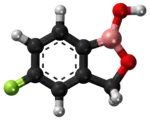Tavaborole
 | |
 | |
| Names | |
|---|---|
| Trade names | Kerydin |
| Other names | AN2690 |
IUPAC name
| |
| Clinical data | |
| Drug class | Antifungal[1] |
| Main uses | Fungal infections of the nail[1] |
| Side effects | Skin irritation, ingrown toenail[1] |
| WHO AWaRe | UnlinkedWikibase error: ⧼unlinkedwikibase-error-statements-entity-not-set⧽ |
| Pregnancy category |
|
| Routes of use | Topical |
| External links | |
| AHFS/Drugs.com | Monograph |
| MedlinePlus | a614049 |
| Legal | |
| Legal status |
|
| Chemical and physical data | |
| Formula | C7H6BFO2 |
| Molar mass | 151.93 g·mol−1 |
| 3D model (JSmol) | |
SMILES
| |
InChI
| |
Tavaborole, sold under the brand name Kerydin, is an antifungal medication used to treat fungal infections of the nail.[1] It is used by applying it to the nail in question.[1] Evidence supports its use in mild to moderate disease.[2]
Side effects may include skin irritation and an ingrown toenail.[1] It works by inhibits a enzyme, leucyl-tRNA synthetase, that is required for fungus to make protein.[1]
Tavaborole was approved for medical use in the United States in 2014.[3] In the United States 10 ml of solution costs about 1,600 USD as of 2021.[4] It is also available in Canada but not in Europe as of 2018.[5]
Medical uses
Tavaborole is used in the treatment of onychomycosis.[3] In clinical trials, tavaborole was more effective than the vehicle (ethyl acetate and propylene glycol) alone in curing onychomycosis. In two studies, fungal infection was eliminated using tavaborole in 6.5% of the cases vs. 0.5% using the vehicle alone, and 27.5% vs. 14.6% using the vehicle alone.[6] It is generally used daily for 48 weeks.[1]
Side effects
Application site skin peeling, skin redness, and irritation are possible side effects, and may occur in less than 5% of individuals.[6]
Pharmacology
Tavaborole acts as an inhibitor of fungal leucyl-tRNA synthetase.[7]
Pharmacokinetics
Tavaborole, when prepared with a 1:1 mixture of ethyl acetate and propylene glycol, has the ability to fully penetrate through the human nail. In studies with cadaver fingernails, a 5% solution of tavaborole penetrated the nail an average of 524.7 mcg/cm2 after two weeks of daily use.[6]
Tavaborole is detectable in the blood at a level of 3.54 ng/mL after a single use of 0.2 mL of the 5% solution. Tavaborole has an elimination half-life of 28.5 hours, a maximum concentration of 5.17 ng/mL after two weeks of daily use, and takes 8 days to reach the maximum concentration.[6]
History
Tavaborole began phase III clinical trials in December 2010[8] and was approved by the US FDA in July 2014.[9]
Society and culture
Economics
Originally developed by Anacor, it is now marketed in the United States by Novartis subsidiary Sandoz. Anacor was paid US$65 million and also entered into a profit sharing scheme for future sales.[10] A 10 mL bottle of a 5% solution of tavaborole will cost the patient without insurance about $1,356.[11]
See also
Crisaborole – a structurally related topical medication used for the treatment of mild-to-moderate atopic dermatitis (eczema)
References
- 1 2 3 4 5 6 7 8 "Tavaborole Monograph for Professionals". Drugs.com. Archived from the original on 21 May 2016. Retrieved 23 September 2021.
- ↑ Jinna, S; Finch, J (2015). "Spotlight on tavaborole for the treatment of onychomycosis". Drug design, development and therapy. 9: 6185–90. doi:10.2147/DDDT.S81944. PMID 26640371.
- 1 2 Gupta, Aditya K.; Mays, Rachel R.; Folley, Kelly A. (2019). "42. Topical antifungal agents". In Wolverton, Stephen E.; Wu, Jashin J. (eds.). Comprehensive Dermatologic Drug Therapy (4th ed.). Elsevier. p. 488. ISBN 978-0-323-61211-1. Archived from the original on 2021-10-09. Retrieved 2021-10-07.
- ↑ "Kerydin Prices, Coupons & Patient Assistance Programs". Drugs.com. Archived from the original on 15 January 2021. Retrieved 23 September 2021.
- ↑ Rigopoulos, Dimitris; Elewski, Boni; Richert, Bertrand (6 August 2018). Onychomycosis: Diagnosis and Effective Management. John Wiley & Sons. p. 105. ISBN 978-1-119-22653-6. Archived from the original on 23 September 2021. Retrieved 23 September 2021.
- 1 2 3 4 Elewski BE, Aly R, Baldwin SL, González Soto RF, Rich P, Weisfeld M, et al. (July 2015). "Efficacy and safety of tavaborole topical solution, 5%, a novel boron-based antifungal agent, for the treatment of toenail onychomycosis: Results from 2 randomized phase-III studies". Journal of the American Academy of Dermatology. 73 (1): 62–9. doi:10.1016/j.jaad.2015.04.010. PMID 25956661.
- ↑ Markinson B, Ghannoum M, Winter T, Rycerz A, Rock F, Gupta AK. Examining the Benefits of the Boron-Based Mechanism of Action and Physicochemical Properties of Tavaborole in the Treatment of Onychomycosis. J Am Podiatr Med Assoc. 2018 Jan;108(1):12-19. doi:10.7547/16-154 PMID 29547036
- ↑ Clinical trial number NCT01270971 for "Efficacy and Safety Evaluation of AN2690 Topical Solution to Treat Onychomycosis of the Toenail" at ClinicalTrials.gov
- ↑ "FDA Approves Anacor Pharmaceuticals' KERYDIN™ (Tavaborole) Topical Solution, 5% for the Treatment of Onychomycosis of the Toenails". Market Watch. July 8, 2014. Archived from the original on 2017-12-26. Retrieved 2020-12-22.
- ↑ "Anacor's Kerydin to Be Commercialized by Sandoz in the U.S." Zacks.com. 22 July 2014. Archived from the original on 28 October 2015. Retrieved 7 October 2015.
- ↑ "Kerydin". Archived from the original on 2 September 2015. Retrieved 12 August 2015.
External links
| External sites: |
|
|---|---|
| Identifiers: |